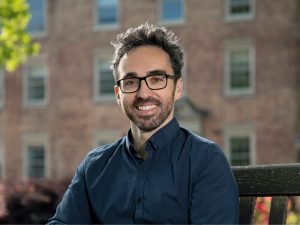Meet Pedro Sáenz
October 7, 2021
Endeavors

Pedro Sáenz is an assistant professor and director of the Physical Mathematics Laboratory. (Photo by Alyssa LaFaro)
Pedro Sáenz is an assistant professor and director of the Physical Mathematics Laboratory in the mathematics department in the College of Arts & Sciences. He works to demonstrate that some odd behaviors displayed by electrons and other atomic-sized particles can be recreated with larger particles visible to the human eye.
When you were a child, what did you want to be when you grew up?
I grew up in a very rural part of Spain, in a village of just 400 people, so my interests at the time ranged from things like construction — building cabins with my friends — to exploration of the nearby mountains. In college, I ended up studying mechanical engineering, and now I teach mathematics and do research in physics. I guess I have always liked interdisciplinary work.
Share the pivotal moment in your life that helped you choose your field of study.
My father was a farmer and my mother a factory worker, so for me to go to college was already a big step for my family. Then I moved to Edinburgh for a gap year with the intention of eventually coming back to Spain. After a series of unplanned events, I started my doctoral studies there. That’s when I really discovered my passion for fundamental research.
Tell us about a time you encountered a tricky problem. How did you handle it and what did you learn from it?
Once, I had been working on a project for months and, toward the end, thought that measuring and averaging the amplitude of very small waves might yield an interesting observation. This was an unexpected — and frustrating — last-minute thought for an otherwise complete work that I wanted to submit for publication as soon as possible. The measurements I wanted to make were challenging and could have delayed me for weeks, even months. By distancing myself from the problem, I realized that all I needed could be done with data we already possessed. In the end, it took me 10 minutes to make the calculation, and the prediction was correct.
When I find myself in front of a problem that I’m struggling with, I try to recognize it and do something different. I’ve lost count of the number of times when I’ve felt stuck and frustrated. Oftentimes, I stop working, go for a run, and come up with an idea that allows me find a way around a problem.
Describe your research in five words.
Large-scale recreations of atomic processes.
What are your passions outside of research?
Coming from Spain, cooking and socializing over food is a big part of my culture. During the summer, we often get together to cook paella and spend the afternoon eating and chatting about anything. I’m also a regular runner and love doing exercise outdoors, things like kayaking in summer and skiing in winter. I enjoy going on hikes and road trips. Visiting any national park is a great excuse that allows me to combine both.
